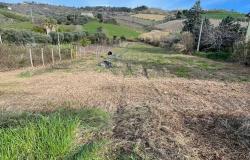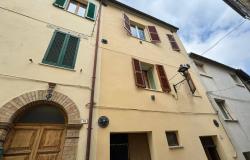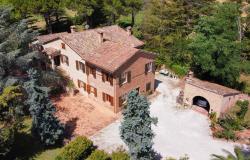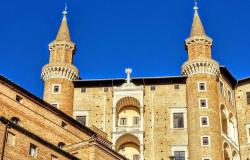For an authentic glimpse of other-era Italy, a visit to the country’s small, sometimes very small hill towns (with populations under 1000 and requiring several clicks on Google Maps for their names to come into view), provides the chance to experience a way of life that seems like a post card from gentler times. Despite their size, these medieval and Renaissance areas dotting hillsides and mountaintops house many art and architectural treasures, the patrimony of deeply layered histories often reaching to the Etruscan era. Central Italy, carved by the Umbro-Marchigian Apennines, has a particularly rich bounty of these fortified villages little known outside their region or beyond Italy’s borders. But they are well worth the visit, offering profound beauty, painterly vistas, hyper-local cooking, historic lodging (including alberghi diffusi, which can mean an especially immersive small-town experience). Here are seven of these villages in the beautiful regions of Le Marche and Umbria to consider for your next trip to Italy. (They are listed from North to South.)
GRADARA (30 kilometers/19 miles from Rimini)
Gradara was home to a number of Italy’s most powerful families during the Middle Ages and Renaissance, including the Sforza and Della Rovere clans. It is also the setting for a massive, well-preserved castle where Lucrezia Borgia, whose first husband was Giovanni Sforza, lived. (When visiting the royal apartment you can see her dressing room.) The castle was the backdrop for the doomed love affair between the young aristocrats Paolo Malatesta and Francesca da Rimini, immortalized by Dante in the fifth canto of the Inferno. (The tale, recounted by Boccaccio as well, may have served as Shakespeare’s inspiration for Romeo and Juliet.) Despite the not-so-happy endings (Lucrezia Borgia’s marriage at 13 to Giovanni Sforza was annulled), the town, thanks to the castle setting and the Giro di Ronda, a roughly 300-meter walkway that affords sweeping views of the Adriatic and countryside, is considered one of Italy’s most romantic spots. After your finish the Giro pause for an aperitivo, perhaps with a Le Marche sparkling wine paired with the Marchigiani bruschetta, crostini al tartufo.

TREIA (48 kilometers/30 miles from Ancona)
A pristine town whose origins date to 380 BC, Treia was likely founded by the Sabines, an ancient Italic tribe living in the Apennines. Eventually colonized by Rome, its fate was linked to that of its overlords—Treia was deserted after the Empire collapsed in the 5th century and resettled only in the Middle Ages when it was called Montecchio. (After becoming part of the Papal States in the late 1700s, the town was named Treia again.) The Piazza della Repubblica, fronted by the Renaissance-style Palazzo Comunale, is one of Italy’s most beautiful town squares. Treia’s Museo Civico Archeologico is worth a visit to see artifacts from Roman and medieval times. The local specialty to try is calcione, a ricotta, egg, and herb savory pastry.
CINGOLI (53 kilometers/33miles from Ancona)
The beauty of this village 2100 feet about sea level is matched by its views, which would make any cinematographer swoon—they reach from the Adriatic to the mountains of Croatia. Founded as a strategic lookout in Roman times (63 BC) by Titus Labienus, an aide-de-camp to Julius Caesar, the art and architecture here cover a wide range of periods: there’s a medieval Town Hall, home to the archaeological museum housing local memorabilia from the Stone Age; the Baroque Cingoli Cathedral (constructed for Pope Pius VIII, who came from the town) and the Gothic Palazzo Conti. There are fine paintings by Lorenzo Lotto and other area painters at the Cingoli Art Gallery, as well as more recent works by 19th and 20th century artists. A favorite Cingoli dish is potato gnocchi with duck ragu, all the better when accompanied by a Rosso Conero or Verdicchio produced in Le Marche.
MONTE CASTELLO DI VIBIO (45 kilometers/ 28 miles from Perugia)
Home to the world’s smallest theater, the Teatro della Concordia built in 1808 when Napoleon ruled the land, Monte Castello di Vibio was named after a noble Roman family, the Vibia, who owned large tracts of land in the region. Check out the Torre di Maggio, a medieval tower that marks the entrance to the town and the 15th century Chiesa di Sant’ Illuminata. The views from Piazza Vittorio Emanuele II look south over the Umbrian hills and valleys to the Lazio and Abruzzo mountains. Monte Castello di Vibio is known for its production of fine extra virgin olive oil; sample it with lamb chops prepared with olive oil and garlic, a favorite entree here.

SCHEGGINO (14 kilometers/10 miles from Spoleto)
This tiny hill town, once ruled by the dukes of Spoleto, is home to two historic churches and a truffle museum. During the great Guelph-Ghibelline conflicts in the Middle Ages, Scheggino was firmly in the Guelph camp (the Guelphs tended to be the business class supporting the Papal State; the Ghibellines, nobleman lining up behind the Holy Roman Empire). In the 16th century many towns in the Valnerina fought for independence, although Scheggino, despite an uprising lead by Picozzo Brancaleoni da Scheggino, remained loyal to the papacy. Don’t miss the Chiesa di San Nicolo with frescoes by Lo Spagna, a noted Renaissance painter and student of Perugino, and the rare Romanesque Church of Santa Felicita. The Museo del Tartufo was built by the Urbani family, the global truffle purveyor. The dishes to try in Scheggino include strangozzi, often served with black truffles; truffle lumachine, pasta shells with truffles; and the local trout.

VALLO DI NERA (22 kilometers/14 miles from Spoleto)
Vallo di Nera, a medieval hamlet that’s a charming maze of narrow streets and winding stairs (there are no cars), has a population of roughly 430 people. Its roots reach back to ancient times with first settlements dating to the 8th century BC. Later the Romans came and conquered, and in the third and fourth centuries AD Christian Syrian refugees escaped from persecution here.The town’s position as a trading center made it a hot property, contested by the Papal State and Spoleto in the Middle Ages. Vallo di Nera has many beautiful views and historic churches, including the Romanesque Chiesa di San Giovanni Battista and the Chiesa di Santa Maria with frescoes from the school of Giotto. The local specialties include pasta with aromatic herbs and agnello scottadito, grilled lamb chops.
 [Di LigaDue - Opera propria, CC BY 3.0, Photo credit: Wikimedia Commons]
[Di LigaDue - Opera propria, CC BY 3.0, Photo credit: Wikimedia Commons]
SANT' ANATOLIA DI NARCO (12 kilometers/8 miles from Spoleto)
Although medieval in appearance Sant' Anatolia di Narco, colonized in Etruscan times, is the oldest settlement in the Valnerina. (Ancient artifacts from the town are on display in the National Archaeological Museum in Florence). Just below the town is the Chiesa dei Santi Felice e Mauro, named for Syrian refugees who settled in a cave near the church’s site and were later granted sainthood. The abbey complex, the Abbazia dei Santi Felice e Mauro, also includes lodging and a restaurant. If you like to hike, try the route from Sant Anatolia di Narco crossing the Nera River to the Abbazia di San Pietro in Valle in Ferentillo, a Romanesque church with extraordinary 12th-century frescoes that Giotto used as inspiration.This abbey complex also has lodging and a restaurant.

For more coverage of the Apennine hill towns, see Italy Magazine’s coverage of San Gemini and Amelia.








